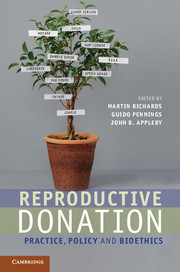Book contents
- Frontmatter
- Contents
- Contributors
- Acknowledgements
- 1 Introduction
- 2 The biology of donation
- 3 Ethics for reproductive donation
- 4 Parenthood – whose right is it anyway?
- 5 Reproductive donation
- 6 UK and US perspectives on the regulation of gamete donation
- 7 Gamete and embryo donation
- 8 The legal and ethical regulation of transnational donation
- 9 Balancing ethical criteria for the recruitment of gamete donors
- 10 Challenges in intra-family donation
- 11 ARTs and the single parent
- 12 Reproductive donation and justice for gay and lesbian couples
- 13 Is disclosure in the best interests of children conceived by donation?
- 14 Identifiable donors and siblings
- 15 Ethical issues in embryo donation
- 16 Reproduction through surrogacy
- 17 Some conclusions regarding the interaction of normative and descriptive elements in reproductive donation
- Index
- References
7 - Gamete and embryo donation
a legal view from Spain
Published online by Cambridge University Press: 05 August 2012
- Frontmatter
- Contents
- Contributors
- Acknowledgements
- 1 Introduction
- 2 The biology of donation
- 3 Ethics for reproductive donation
- 4 Parenthood – whose right is it anyway?
- 5 Reproductive donation
- 6 UK and US perspectives on the regulation of gamete donation
- 7 Gamete and embryo donation
- 8 The legal and ethical regulation of transnational donation
- 9 Balancing ethical criteria for the recruitment of gamete donors
- 10 Challenges in intra-family donation
- 11 ARTs and the single parent
- 12 Reproductive donation and justice for gay and lesbian couples
- 13 Is disclosure in the best interests of children conceived by donation?
- 14 Identifiable donors and siblings
- 15 Ethical issues in embryo donation
- 16 Reproduction through surrogacy
- 17 Some conclusions regarding the interaction of normative and descriptive elements in reproductive donation
- Index
- References
Summary
Introduction
Spain has a strong culture of family life. Family relationships are often close and people grow up aspiring to have their own children. So, if a couple find that they are infertile and may need the assistance of a gamete donor to have children, this can be deeply disturbing. Their hopes and expectations of having ‘their own’ children may crumble and their feelings of esteem and personal worth can be jeopardized. Many feel deeply frustrated and find this one of the most challenging situations they have had to face in life. In Spain there is little understanding of what conception by assisted reproduction techniques (ARTs) is and no knowledge of gamete donation, and this can make the experience even more difficult for prospective parents.
It is estimated that at least three million children have been conceived in fertility clinics, according to the statistics collected by the European Society for Human Reproduction and Embryology (De Mouzon et al., 2010). This figure is an underestimate, since the report only collects data from fifty-two countries and about two thirds of the global activity of ARTs. ARTs have brought a revolution with medical, social and legal implications for Spanish society. Since the birth of Spain’s first IVF baby, Anna Victoria, at the Dexeus Clinic in Barcelona in 1984, Spain has experienced many changes in the development of ARTs. Expectations – and controversies – have grown with the development of egg donation and more recently with the possibility of freezing and storing eggs. Since the late 1980s, many countries have enacted laws designed to regulate these practices. However, far from achieving a consensus, legislation has been characterized by diversity, especially in the most controversial areas, such as the involvement of donors in the reproductive process. Maintaining donor anonymity, payment for donation, the risks to the health of the donor (in the case of egg donation), the relevance for children’s welfare of knowing their biological origins, the importance of limiting the total number of donations by a donor and recording donations in a donor registry have all been regulated differently in jurisdictions around the world. Currently, these issues are raising new legal challenges that are leading to significant legislative changes in some countries.
- Type
- Chapter
- Information
- Reproductive DonationPractice, Policy and Bioethics, pp. 112 - 129Publisher: Cambridge University PressPrint publication year: 2012
References
- 7
- Cited by



